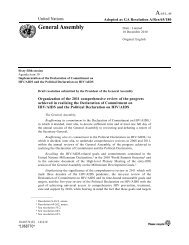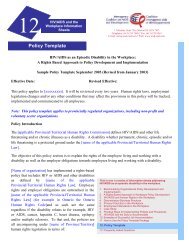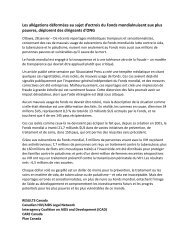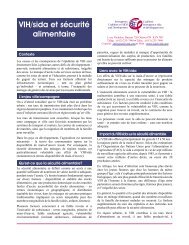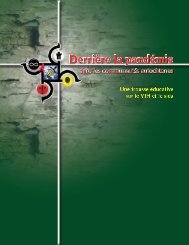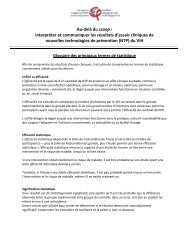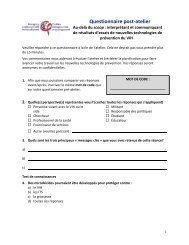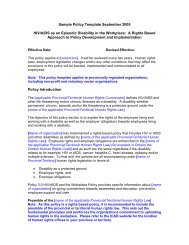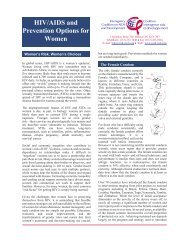Behind the Pandemic in Aboriginal Communities - Interagency ...
Behind the Pandemic in Aboriginal Communities - Interagency ...
Behind the Pandemic in Aboriginal Communities - Interagency ...
- No tags were found...
Create successful ePaper yourself
Turn your PDF publications into a flip-book with our unique Google optimized e-Paper software.
Aborig<strong>in</strong>al peoples are <strong>in</strong>dividuals who identify <strong>the</strong>mselves as Aborig<strong>in</strong>al and areaccepted by members of <strong>the</strong>ir community as Aborig<strong>in</strong>al; have a historical l<strong>in</strong>k to <strong>the</strong> landfrom <strong>the</strong> time before colonization or annexation; have a strong l<strong>in</strong>k to territories andnatural resources; have dist<strong>in</strong>ct social, economic, and political systems; have dist<strong>in</strong>ctlanguages, cultures, beliefs and knowledge systems; want to ma<strong>in</strong>ta<strong>in</strong> <strong>the</strong>ir identity asdist<strong>in</strong>ct peoples and communities; and are from non-dom<strong>in</strong>ant groups <strong>in</strong> society (UNPFII<strong>in</strong> Papan, 2009). Aborig<strong>in</strong>al peoples <strong>in</strong>clude Métis, Inuit, and First Nations regardlessof where <strong>the</strong>y live <strong>in</strong> Canada and whe<strong>the</strong>r <strong>the</strong>y are ‘registered’ under <strong>the</strong> Indian Act ofCanada.AIDS is <strong>the</strong> acronym for Acquired Immune Deficiency Syndrome. This is a medicaldiagnosis given when a person is at an advanced stage of HIV disease.Broader determ<strong>in</strong>ants of Aborig<strong>in</strong>al health <strong>in</strong>corporate <strong>the</strong> historical socio-politicalcontext to situate contemporary health disparities that are evident <strong>in</strong> Aborig<strong>in</strong>alcommunities (First Nations, Métis, and Inuit). These broader determ<strong>in</strong>ants attempt tocapture <strong>the</strong> policy environment that has created chaos for <strong>in</strong>dividuals and communitiesand cont<strong>in</strong>ues to challenge resilience.Community HIV competence describes a community’s read<strong>in</strong>ess and ability to respondto HIV epidemics. HIV competent communities have an accurate understand<strong>in</strong>g ofHIV, safe social spaces to discuss how HIV relates to <strong>the</strong>ir own lives, solidarity amongcommunity members, a sense of ownership over <strong>the</strong> problem, a sense of responsibilityto contribute to solutions, confidence <strong>in</strong> <strong>the</strong> community’s ability to effectively respond,access to outside resources (f<strong>in</strong>ancial, technical, etc.) and networks to support efforts.Cultural competence is a term used to describe <strong>the</strong> skills, knowledge, and attitudes thatenable health practitioners to provide respectful care to patients of diverse cultures.Cultural cont<strong>in</strong>uity describes <strong>the</strong> <strong>in</strong>tergenerational capacity to transmit and re<strong>in</strong>forceAborig<strong>in</strong>al knowledge and cultural practices <strong>in</strong> families and communities.Cultural safety is a term that is replac<strong>in</strong>g cultural competence. It shifts <strong>the</strong> focus of culturallyappropriate health services from <strong>the</strong> sole responsibility of <strong>the</strong> health practitioner toa shared responsibility of <strong>the</strong> health practitioner and patients. Cultural safety is an outcomewhereby patients and health practitioners work toge<strong>the</strong>r <strong>in</strong> an equal and respectfulmanner to decide how to manage <strong>the</strong> patient’s health. This exposes and manages powerrelationship <strong>in</strong>herent <strong>in</strong> health care services.Determ<strong>in</strong>ants of health are <strong>the</strong> non-medical determ<strong>in</strong>ants that <strong>in</strong>clude gender; culture;<strong>in</strong>come; employment and work<strong>in</strong>g conditions; <strong>in</strong>come and social support; healthy childdevelopment; physical environment; social environment; and personal health practicesand cop<strong>in</strong>g skills.Gender refers to <strong>the</strong> expectations placed on people of a particular sex about how <strong>the</strong>yshould or should not feel, behave, and th<strong>in</strong>k about <strong>the</strong>mselves, <strong>the</strong>ir bodies, and <strong>the</strong>irroles <strong>in</strong> relationships and society. These expectations vary across cultures and historicaltimes.104



